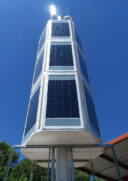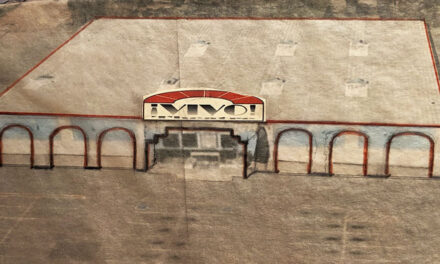LOS LUNAS—A new, potentially game-changing solar technology went online in June at the Los Lunas recycling center, making the village the first municipality in the country to install it.

The vertical polygen solar system installed in Los Lunas, shown here, is 30-feet tall and sits beside the village recycling center, providing all facility electricity needs around the clock.
Photo courtesy of Wiltech Energy
Unlike horizontal rooftop systems, the new “vertical polygen” technology is a compact tower that stacks panels vertically around a pole that sits beside the building. It includes a small wind turbine at the top to produce extra energy when the sun isn’t shining, plus back-up battery storage to supply electricity 24/7 with no connection to Public Service Company of New Mexico or any other utility grid, said Los Lunas Public Works Director Michael Jaramillo.
“It came online in June and it’s been producing all the electricity it’s supposed to,” Jaramillo said. “The facility has been disconnected from PNM for 30 days now with the system powering the lights and all other equipment with no issues.”
The system — designed, built and installed by Wiltech Energy LLC — cost $83,000. It generates 20 kilowatts of power with a 22 KW battery back-up system.
Since the recycling facility only consumes about 15 KW per day, the system offers about 25 percent more electricity than needed to ensure a steady supply day and night, Jaramillo said. It channels only as much electricity to the facility as needed through computer monitoring and regulation, storing all excess energy.
“The system is projected to run at least 20 years, with a full return on investment expected in four years,” Jaramillo said. “It’s 100 percent off the grid. If there were a blackout today, it would continue to produce without any electricity pulled from PNM.”
The Los Lunas installation marks Wiltech’s first commercial thrust into building and deploying the system in New Mexico and beyond, said founder and CEO Oswald Wilson. The company wants to build a manufacturing plant in Los Lunas.
“New Mexico offers 300 days of sunshine a year, so it’s a good place to start producing the technology and demonstrate it,” Wilson said. “Los Lunas is the very first place we’ve installed it, giving us the chance to deploy, test and showcase it. Our preference is to locate our manufacturing plant and headquarters there and then expand the technology to other parts of New Mexico.”
Built to meet a need
Originally from Jamaica, Wilson has lived in New Jersey since 1983. He worked for years as a maintenance engineer with ABC News. During his travels with the TV station, he noticed a broad need for generating systems that occupy little space to boost solar deployment in land-strapped places, such as crowded cities like Manhattan or small island nations in the Caribbean. That’s when he conceived of a vertical system, which he began building in his garage in New Jersey, creating an initial prototype by 2011.
Then Hurricane Sandy hit in November 2012. Wilson powered up his system, successfully providing electricity to his home during and after the storm and accelerating his efforts to build out the system for commercial use.
Wilson said his vertical panels offer major advantages over today’s horizontal systems.
“The idea that you must point the panels at the sun is a myth,” Wilson said. “Wherever the sun hits, it will generate power, whether it’s vertical or horizontal. With flat systems, the sun is more directly concentrated on the panels, which generates more radiated heat, making them less efficient.”
In addition, in places like the Northeast, solar systems lose power in winter as snow accumulates on panels, reducing sunlight.
“With a vertical configuration, the snow falls to the ground where it acts as a reflector to shine more sunlight on the panels,” Wilson said.
It’s the same with sand and dust, which fall off the vertical system rather than accumulate, he said.
The solar towers occupy a fraction of the space needed for horizontal systems, and they can easily be scaled up vertically by adding more levels. Wilson says his system can generate two megawatts of electricity in a one-acre area, compared with just 1 MW in a 4.5- to 5-acre area with horizontal systems.
“It occupies a very small footprint and generates energy around the clock,” Wilson said. “You can install them for a solar farm, a micro grid, or individually for homes, businesses and industry.”
The company wants to build a broad variety of systems to power everything from street lighting to cell towers and electric charging stations.
“You can place them up and down I-40 and I-25 to provide vehicle charging stations every 50 or 100 miles,” Wilson said. “We plan to promote them on Native American reservations like the Navajo Nation, where they’re really suffering from COVID-19. It can provide power to pump water along with electricity.”
Centered on New Mexico
Wilson expects to move soon to New Mexico, where two company executives — Operations Director Jim Lee and Project Manager Angela Jefferson — are already located.
The firm is seeking partnerships with system integrators in the U.S. and elsewhere, and is negotiating with investors to build its manufacturing plant, plus a 2-MW solar farm in Los Lunas to power the plant.
“There’s a lot of curiosity now about the system,” Lee said. “We have several inquiries, but it may take some time to deploy it. People need to first understand the significance of our vertical system.”
The new Los Lunas installation can help generate confidence, said Jefferson, an engineering construction veteran with 30 years in the energy industry.
“When something is new, people usually want to wait and see how it works,” Jefferson said. “We’ll work to generate confidence that Wiltech and its product can deliver for customers.”
Los Lunas, meanwhile, is enjoying its status as the first Wiltech customer.
“This installation is the first of its kind in the country, and that’s pretty neat,” Jaramillo said. “If it performs as expected, I believe the village is interested in expanding it to other facilities.”















